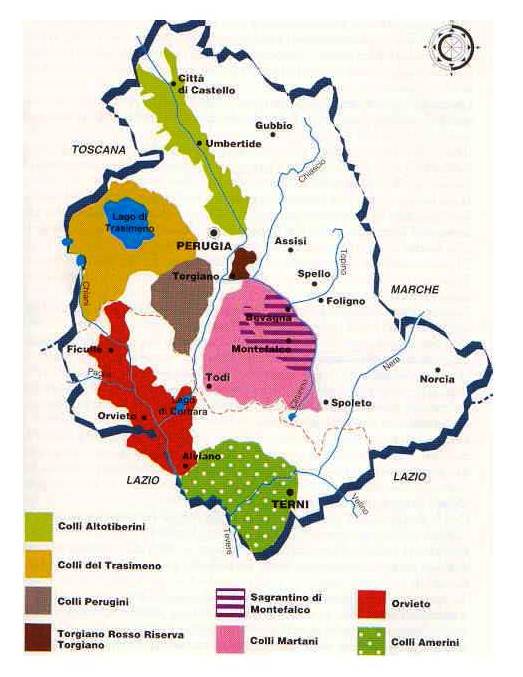Tucked down in the centre of Italy, Umbria is frequently overlooked in favour of its more well-known neighbours, Lazio and Tuscany. But hidden among the rolling hills and mediaeval villages of this isolated paradise is a wine jewel that begs to be found: the Sagrantino grape. Sagrantino is a native variety that has become the undiscovered treasure of Umbria, enticing wine lovers with its powerful flavours, potential for ageing, and the intricate cultural background surrounding its production.
Umbria: The Green Heart of Italy
Known as the “green heart” of Italy, Umbria is a region celebrated for its lush landscapes, picturesque hilltop villages, and a sense of timelessness that pervades its vineyards. Bordering Tuscany to the west and Le Marche to the east, Umbria remains largely unspoiled by the hustle and bustle of more touristy regions, offering a tranquil retreat for those seeking a genuine Italian experience.
The vine-covered hills of Umbria, interspersed with olive groves and cypress trees, create an enchanting panorama. It is within this idyllic setting that the Sagrantino grape finds its home, thriving in the region’s unique microclimate and contributing to the distinctive character of Umbrian wines.

Sagrantino: A Grape with Ancient Roots
While Sagrantino’s origins are somewhat mysterious, it is widely believed that the grape has been cultivated in Umbria for centuries. Historically associated with the production of sacramental wines, Sagrantino has deep roots in religious and cultural traditions. The name itself suggests a connection to the sacred, as “sagrantino” is derived from the Italian word “sagra,” meaning feast or festival.
In the late 20th century, Sagrantino underwent a transformation from a niche grape used in liturgical practices to a varietal that gained recognition for its winemaking potential. Today, it stands as one of Italy’s most tannic red grapes, producing wines that are both powerful and age-worthy.
Montefalco: The Epicenter of Sagrantino
Within Umbria, the town of Montefalco has emerged as the epicentre of Sagrantino production. The vineyards surrounding Montefalco benefit from a combination of factors that contribute to the grape’s exceptional quality. The region’s elevation, well-drained soils, and a Mediterranean climate with warm days and cool nights create optimal conditions for the cultivation of Sagrantino.
Montefalco is not only a geographical focal point but also a cultural one. The town’s medieval charm, with its cobblestone streets and ancient city walls, provides a backdrop that seamlessly complements the historical significance of Sagrantino. Visitors to Montefalco can explore its enoteche (wine shops), where they can sample a variety of Sagrantino wines and gain a deeper understanding of the grape’s nuances.
Sagrantino in the Glass: A Symphony of Flavours
Sagrantino wines are renowned for their robust character, deep colour, and high tannins. In the glass, a well-crafted Sagrantino offers an aromatic journey with notes of dark fruits, blackberries, and plums, complemented by hints of spice, leather, and tobacco. The palate is often characterized by a bold structure, with gripping tannins that provide a firm backbone and a long, lingering finish.
While Sagrantino is predominantly known for its red wines, some producers experiment with different winemaking techniques, including passito-style wines. In this method, grapes are dried before fermentation, resulting in a richer, more concentrated wine with elevated sweetness.
Sagrantino’s Aging Potential: Patience Rewarded
One of Sagrantino’s most compelling attributes is its remarkable aging potential. The grape’s high tannin levels and acidity contribute to the wine’s ability to evolve and improve over time. Many Sagrantino wines are released as Riservas, indicating extended aging requirements, and some can continue to mature gracefully for decades.
As Sagrantino ages, it transforms the bottle, revealing new layers of complexity and nuance. The initially robust tannins tend to mellow, allowing the wine’s intricate flavors to shine. Those who have the patience to cellar Sagrantino are rewarded with an exceptional tasting experience that captures the essence of Umbria’s terroir.
Preserving Tradition in a Modern Context: Sagrantino’s Renaissance
As Sagrantino gains recognition on the international stage, Umbrian winemakers find themselves at a crossroads between preserving tradition and embracing modern winemaking practices. While the grape’s historical significance remains a source of pride, there is a growing acknowledgment of the need for innovation to ensure the continued success of Sagrantino wines.
Some winemakers are experimenting with different oak aging regimens, fermentation techniques, and vineyard management practices to enhance Sagrantino’s expressiveness while maintaining its authenticity. The goal is to strike a balance that respects the grape’s heritage while appealing to contemporary palates.
Noteable Sagrantinos wine producer:
Tabarrini, Arnaldo Caprai, Cantina Fratelli Pardi, Rocca di Fabbri, Tenuta Alzatura